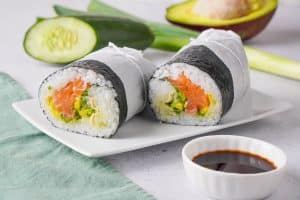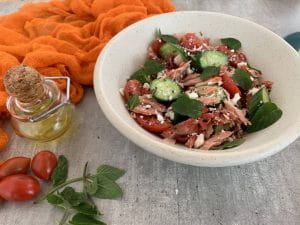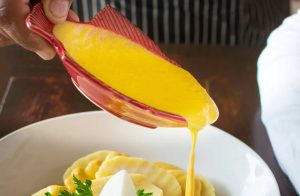Easy Japanese Grilled Eel Bowl
Important Note: When you buy through our links, we may earn a commission. As an Amazon Associate we earn from qualifying purchases. Content, pricing, offers and availability are subject to change at any time - more info.
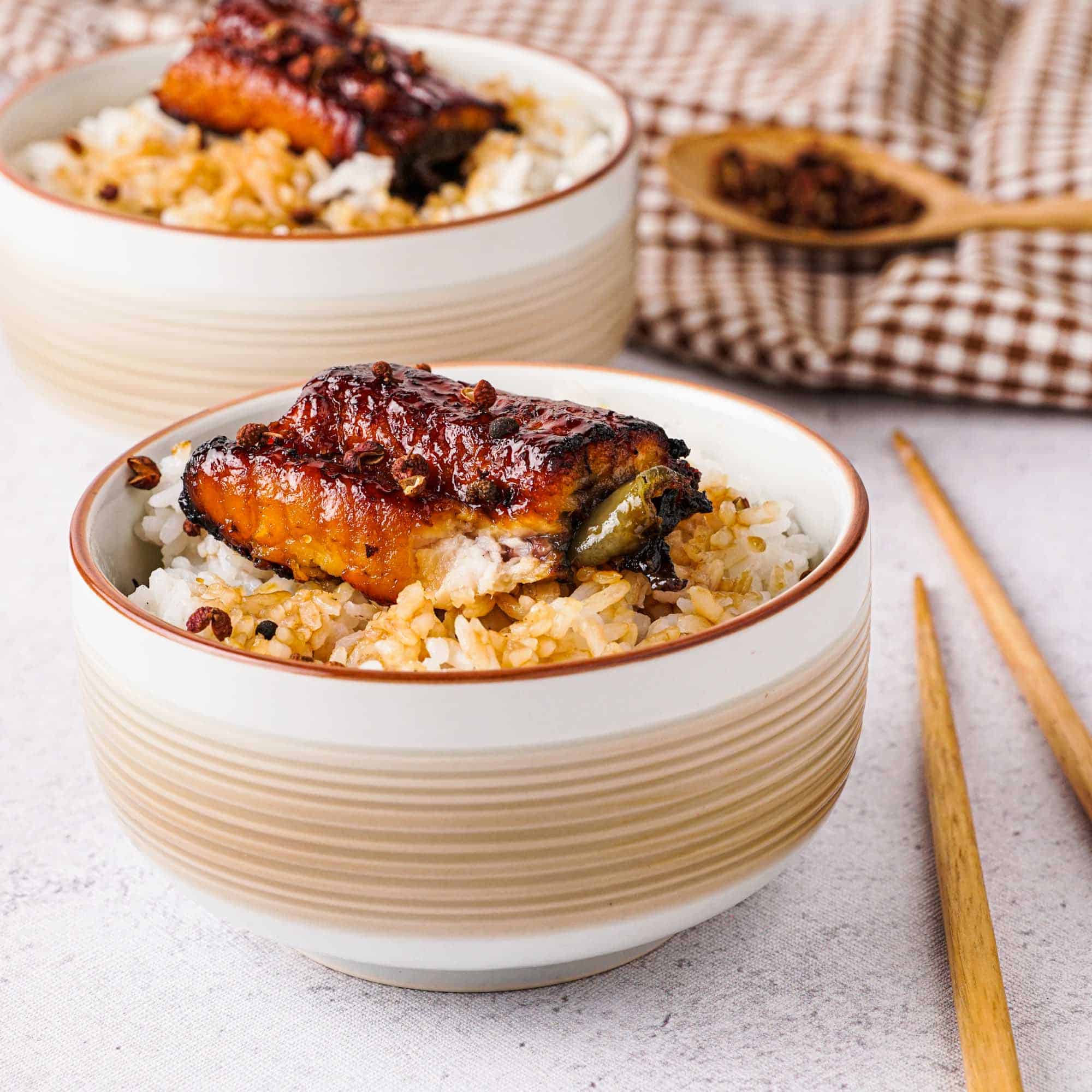
Ingredients
- 1 package of frozen grilled eel thawed
- Cooking oil spray
- 12 oz. cooked rice
- Japanese sansho pepper optional
Unagi sauce:
- 4 Tbsp. mirin
- 1 ½ Tbsp. sake
- 2 ½ Tbsp light brown sugar
- 4 Tbsp. soy sauce
Instructions
- Add the mirin, sake, and sugar to a small saucepan. Heat it over medium and whisk to combine. Add the soy sauce and bring to a boil, reduce to a simmer.
- Simmer for about 10-15 minutes or until the sauce reduces to 1/3 of its volume.
- When almost ready, the sauce will thicken and you will see more bubbles. Measure the volume with the chopsticks and remove the sauce from the heat.
- Cut the unagi fillet in half, thirds, or quarters to fit the donburi serving bowls.
- Preheat the broiler on high (550ºF/288ºC) for 5 minutes with the rack placed in the center of the oven (about 8 inches away from the top).
- Line a baking tray with aluminum foil for easy cleanup and brush or spray the foil with oil. Put the cut unagi pieces on the foil with the skin side down.
- Broil them for about 5-7 minutes until the surface is slightly blistered.
- Open the oven and carefully yet generously brush the top of the unagi with the unagi sauce. Then broil for another 30-60 seconds until the sauce is bubbling.
- Place the hot steamed rice in individual bowls and brush it with some sauce.
- Place fillets of unagi in each rice bowl, then pour or brush more unagi sauce on top. Serve immediately with optional sansho pepper to garnish.
Nutrition
Japanese grilled eel bowl, called unagi don or unadon, is made with tender grilled eel bathed in a sweet caramelized sauce and served over fluffy steamed rice. It’s traditionally eaten in midsummer in Japan, but unadon is delicious any time of the year.
According to the Chinese zodiac’s twelve signs, Doyo no ushi no hi is the Ox Day. On the Ox Day in the summer, known as doyo, Japanese people traditionally eat eel to refuel and combat the heat.
This tradition stems from the Japanese folklore belief that “one could overcome the summer heat by eating something that had the Japanese syllable of ‘u’ at the head of its name, such as an eel (in Japanese, ‘unagi’) on the Ox Day”.
Other foods starting with ‘u’ that can be eaten are ‘udon’ (Japanese wheat noodles), ‘ume’ (plums), or ‘udo’ (Aralia cordata). But whether this is all marketing or whether it’s true is questionable.
However, eel is rich in vitamin B which helps combat fatigue and appetite loss, so it makes sense to eat it in the summer to gain strength.
Why You’ll Love This Japanese Grilled Eel Recipe
There are multiple ways to prepare eel in Japanese food, but unadon is arguably the best way to prepare eel. The sweet and thick unagi sauce tastes like it was made for eel (as the name suggests, i.e., ‘unagi’ means eel). And with rice, it’s a match made in heaven.
Unagi don is the first donburi ever invented and its success continues to this day thanks to its amazing flavors. Donburi is a Japanese ‘rice bowl dish’ consisting of fish, meat, vegetables, or other ingredients simmered together and served over rice.
It’s super quick to make and feels like an authentic Japanese restaurant experience. Eel unagi don is typically served at specialized eel restaurants in Japan.
You can take it to go! There are two variations of Japanese grilled eel over rice that differ mainly in the serving receptacle – ‘unadon’ is served in a donburi and ‘unaju’ is served in Japanese lacquered ware boxes (perfect for packing a gourmet lunch).
What Do I Need For This Japanese Grilled Eel Recipe?
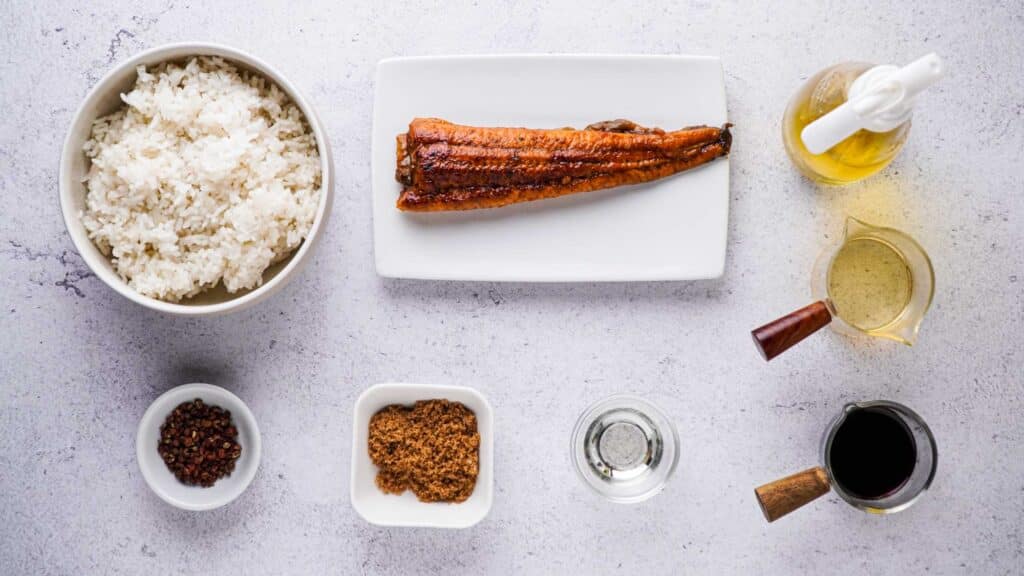
You can make this recipe with fresh eel, but it’s a lot of work. Also, the tastiest eel is Japanese grilled eel, so I recommended buying some at an Asian grocery store.
Ingredients for Unadon:
- 1 package of frozen grilled eel (unagi kabayaki), thawed (1 package is about 5.6 oz, defrosted)
- Cooking oil spray
Unagi sauce:
- 4 Tbsp. mirin
- 1 ½ Tbsp. sake (or Chinese rice wine or water)
- 2 ½ Tbsp light brown sugar
- 4 Tbsp. soy sauce
For serving:
- 12 oz. cooked rice
- Japanese sansho pepper (optional, but recommended)
How To Make Japanese Grilled Eel?
Make sure you have all the ingredients ready and the unagi is defrosted.
Step 1: Make unagi sauce
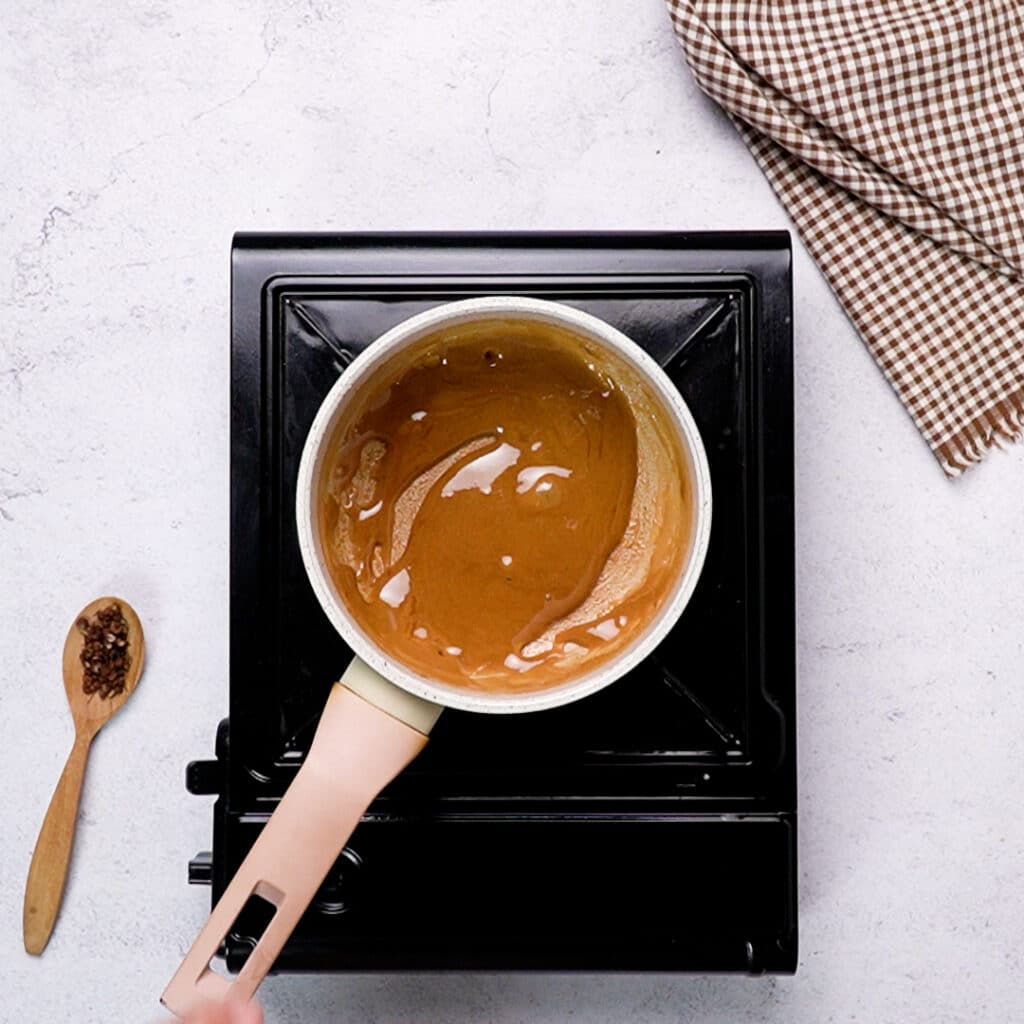
Let’s start with the sauce. Add the mirin, sake, and sugar to a small saucepan. Heat it over medium and whisk to combine.
Add the soy sauce and bring to a boil, then reduce to a simmer.
Continue simmering for about 10-15 minutes or until the sauce reduces to roughly 1/3 of its original volume.
When almost ready, the sauce will thicken and you will see more bubbles. Measure the volume with chopsticks to see if it’s one-third of the original amount and remove the sauce from the heat. As it cools, it’ll continue to thicken.
Step 2: Cut unagi fillet to fit serving bowls.

Cut the unagi fillet in half, thirds, or quarters to fit the donburi serving bowls.
Preheat the broiler on high (550ºF/288ºC) for 5 minutes with the rack placed in the center of the oven (about 8 inches away from the top). Or on medium 500ºF/260ºC about 6 inches away from the heat.
Step 3: Prepare foil-lined tray with oil and place unagi skin side down.
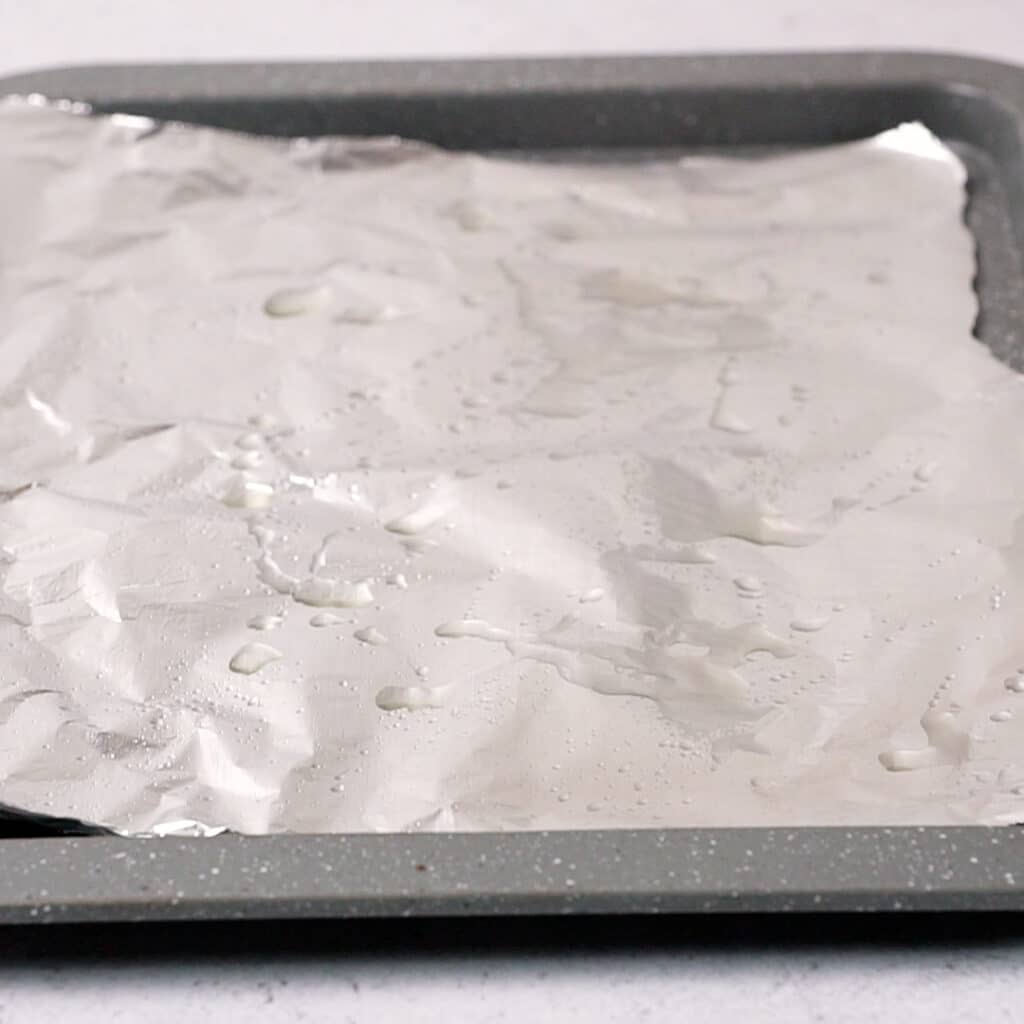
Line a baking tray with aluminum foil for easy cleanup and brush or spray the foil with oil.
Step 4: Place unagi pieces skin side down on foil.
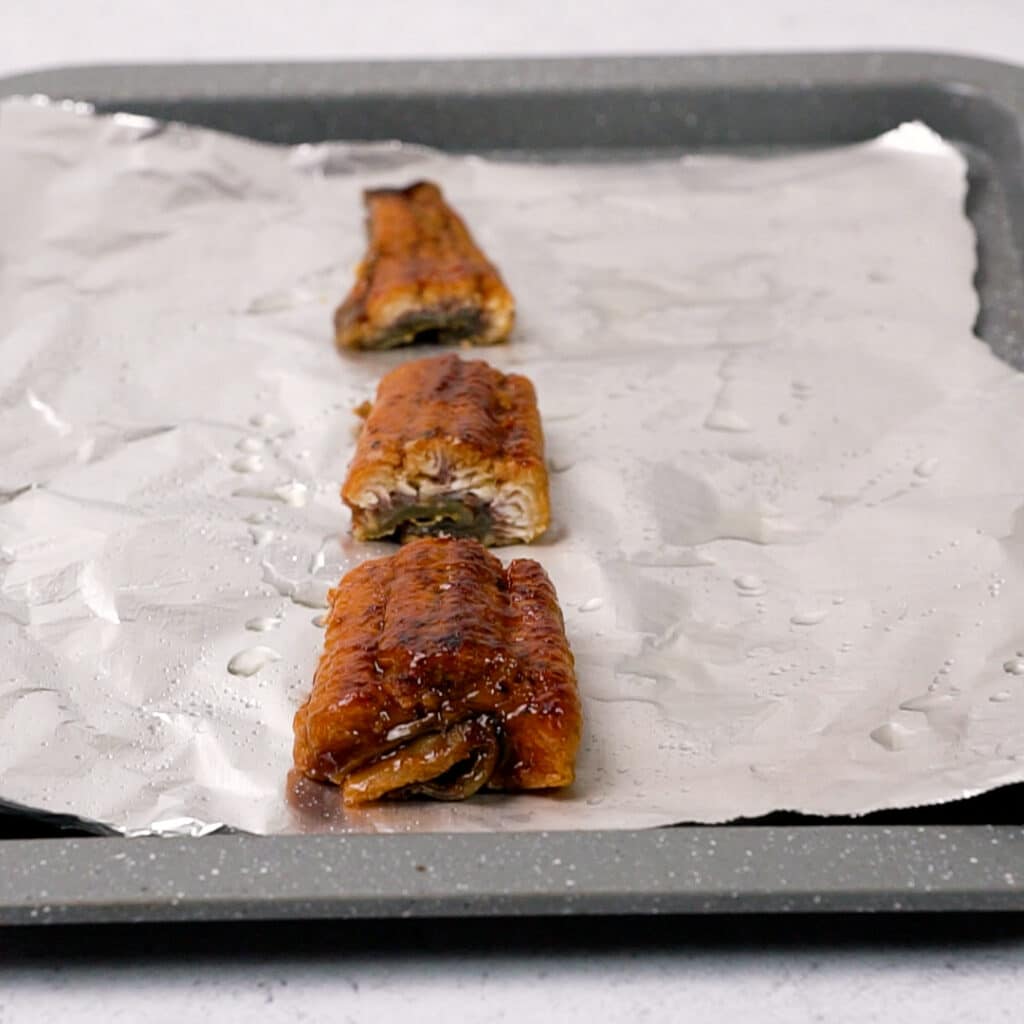
Put the cut unagi pieces on the foil with the skin side down. Broil the fillets for about 5-7 minutes until the surface is slightly blistered. There’s no need to flip.
Step 5: Brush unagi with sauce and broil until bubbling.

Open the oven and carefully yet generously brush the top of the unagi with the unagi sauce. Then broil for another 30-60 seconds until the sauce is bubbling.
Step 6: Serve steamed rice in bowls and brush with sauce.

Place the hot steamed rice in individual bowls and brush it with some sauce.
Place the unagi in each rice bowl, then pour or brush more unagi sauce on top. Serve immediately with optional sansho pepper to garnish.
Notes & Tips
- I recommend doubling or tripling the unagi sauce recipe since it can keep for up to 3 months in the fridge. You can use it to make flavorful donburi for months.
- If the unagi sauce is reduced too much, you can add a bit of water to thin it out. You can even put it back on the stovetop to simmer until perfection again.
- Dip a chopstick into the sauce to measure the level before and after simmering. It should be about one-third of the original level once done.
- You can make this recipe with fresh eel and grill it yourself for a more budget-friendly option, but if you can get your hands on some grilled Japanese eel, it’s so worth it.
- Most Japanese home cooks use pre-grilled Japanese eel (Unagi Kabayaki). It’s not only more convenient but also superior in flavor to eels from other countries. You can find a pretty good price on Bokksu Market, an online Japanese store.
- You can store leftovers in the fridge for up to 3 days, but unagi don is best eaten fresh. If you’re using fresh eel, don’t freeze any leftovers with sauce since that’ll ruin the texture.
What To Serve With Unadon
The most popular way to enjoy unagi don is with Japanese pepper called sansho. This spice is native to Japan. It has a numbing spiciness and fresh aroma with citrus notes.
Besides sansho, unadon is typically served with miso soup or suimono (Japanese clear soup), Japanese-style pickles or fermented vegetables, and more unagi sauce for dipping and drenching the rice in it.
Why Japanese Eel Is So Expensive
Although this mesmerizing fish is not exactly appealing with its sharp teeth and slimy body, it’s highly prized because of its taste. Eel is lightly sweet, devoid of fishiness, and it easily absorbs flavors. You can read more about what eel tastes like here.
But the reason Japanese eel is so expensive is that it’s simply a rare product. They’re challenging to farm and breed, therefore, considered a delicacy. Japanese eel is even classified as an endangered species.





